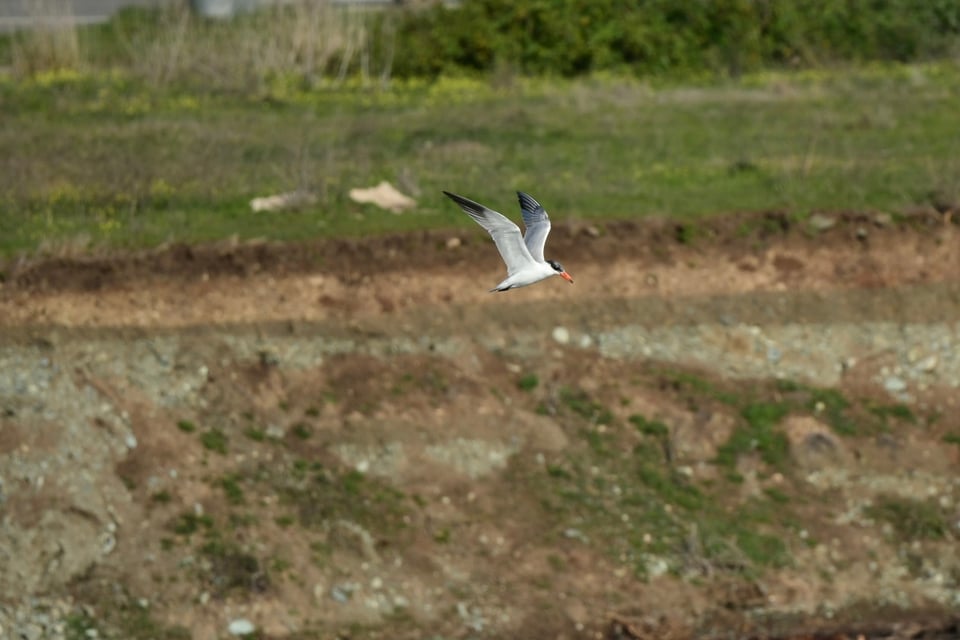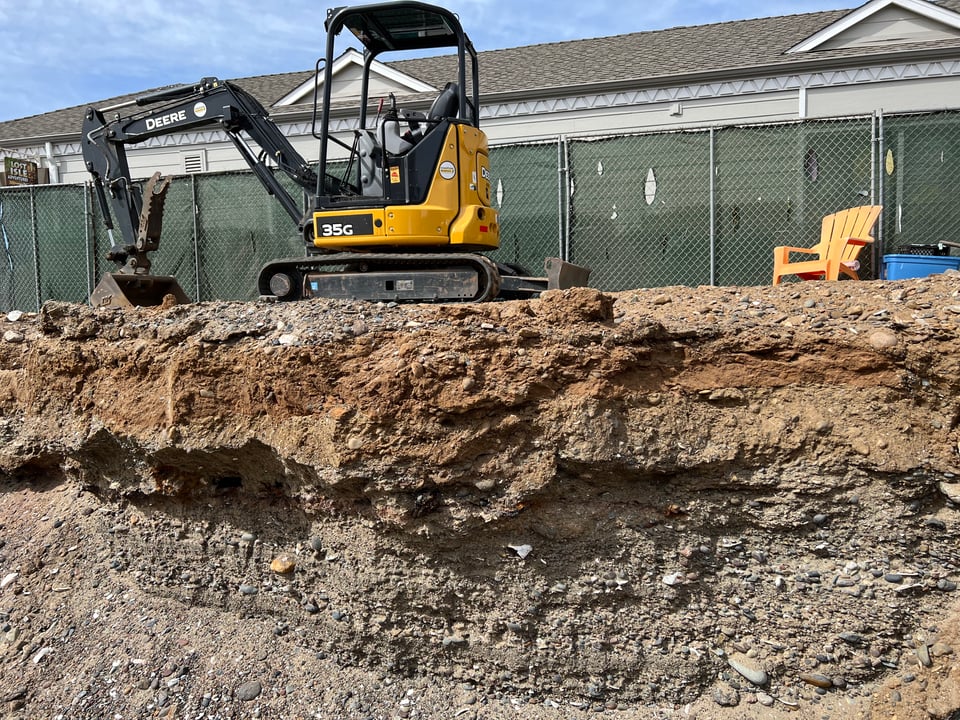hey there, soil friends
In this issue:
- a profile I spotted while out birding
- a shout out to urban soils
- grassland research updates

FROM THE AUTHOR
I come across urban soil profiles perhaps more than any other type of soil profile. Every construction site, whether its a new building complex on campus, or a quick fix of pipework around town, offers a view into the soils beneath our cities. I am as curious about these soils as I am of all other soils. Their proximity to our day to day life intrigues me. This essay draws from that curiosity. I hope you enjoy the essay, and maybe even the audio version!
Thank you for taking the time to care about soil today.
Take care and stay curious,
Yamina

PROFILES
I was delighted when I captured this photo of a Caspian Tern flying perfectly by a soil profile. It got me dreaming about a collection of bird photos that subtly highlight the soils that support bird habitat. This profile has indications of human manipulation - see how easy it is to distinguish between layers of soil? We call these abrupt boundaries. This often happens when humans move and compact soils for construction purposes. This profile is right near a coastal highway, so manipulation during construction seems likely!

Share your recent soil profile sightings with us! Email your photo to wonderofsoil@outlook.com with a caption that includes a general location and I might feature it in a future issue.

FEATURE
Soils in our cities
Human impacts to soils are immense and ubiquitous
We humans have manipulated soils to such an extent, that scientists consider humans as a soil forming factor alongside the other major drivers of soil development (climate, organisms, topography, parent material, and time). Why do we designate ourselves as separate from other organisms that influence soil formation? We see the impacts of our activities as even more intense across even grander spatial and temporal scales than other species. Putting ourselves "above" other species, even when it comes to our ability to degrade the environment, is, perhaps, something only humans would do.
We also indirectly influence soil formation by altering the climate, determining which plants grow where (both intentionally through agriculture, and unintentionally through the introduction of invasive species) and reconstructing the topography of landscapes to manage crops and water movement.
Widespread urbanization and agricultural development has led to the loss of unique, endemic soil types that contribute to a region's "pedodiversity" (the diversity of soil types in an area)1. Somewhat ironically, humans simultaneously decrease pedodiversity and threaten rare soils on regional scales1 , while also increasing pedodiversity within cities through the formation of novel urban soils2.

The soils in our cities have unique features
Urban soils are those dominated by human artifacts and materials that have been moved by human activities2 . They occur not just in cities, but also in suburban areas, industrial regions, and military settings. Because they have been moved and manipulated, urban soils tend to look and feel quite different than their natural soil counterparts3. Urban soils are often compacted when material is moved from one place to another, mixed and compressed to create level surfaces upon which to build, and sealed underneath concrete. This limits how well water soaks into the soil and changes the way water moves within urbanized landscapes.
All that concrete can also change the chemistry of the soil by making the soil more basic4. Modern activities in cityscapes also introduce contaminants, like heavy metals and organic pollutants, that get concentrated in the soil4. In landscaped areas between concrete surfaces, organic carbon can accumulate in the surface soil from purposeful organic amendments like compost or mulch and extra irrigation that promotes plant inputs4.
Even though urban soils are degraded, they can still provide ecosystem services
Urban soils can still provide many ecosystem services that humans rely on[^5]. Your local community garden supports food production. Your neighborhood park provides recreation opportunities and wildlife habitat. A reconstructed wetland mitigates the risk of flood. The microorganisms inhabiting soils in human-dominated landscapes quite literally support human health by suppressing soil-borne diseases and regulating air and water quality5.
All that said, the more degraded an urban soil, the less capacity it has to provide these important ecological functions. Soils with at least some vegetation will fare better than soils in dumping sites or sealed beneath pavement6. In urban greenspaces worldwide, researchers have found that the greater the soil biodiversity, the more ecosystem functions that greenspace will provide7. We can restore urban soils one patch at a time by making space for sidewalk trees, community gardens, green roofs, and rain garden in parking lots8. Stewarding urban soils is both possible and necessary.
Take home message
The soils in our cities are unique, important, and worth paying more attention to. Urbanization and agriculture have both led to widespread soil degradation, the loss of unique soil types, and hindered many ecosystem services. In cities, human activities are creating novel soil types that scientists are actively working to characterize. We need to prioritize both conservation of rare soil types and stewardship of novel urban soils.

NEWS AND UPDATES
Last month, our research team attended the California Native Grasslands Association Science Symposium. We presented our ongoing research on grassland soils around the state. You can learn more about our work, check out the notes from my talk, and see student research posters on my website!
-
Amundson, R., Guo, Y., & Gong, P. (2003). Soil diversity and land use in the United States. Ecosystems, 6, 470-482. ↩↩
-
Pindral, S., Kot, R., & Hulisz, P. (2022). The influence of city development on urban pedodiversity. Scientific Reports, 12(1), 6009. ↩↩
-
The USDA Natural Resource Conservation Service conducts urban soil surveys https://www.nrcs.usda.gov/conservation-basics/natural-resource-concerns/soil/urban-soil-survey ↩
-
Riddle, R. L., Siebecker, M. G., Weindorf, D. C., Shaw, R. K., & Scharenbroch, B. C. (2022). Soils in urban and built environments: Pedogenic processes, characteristics, mapping, and classification. Advances in Agronomy, 173, 227-255. ↩↩↩
-
Wall, D. H., Nielsen, U. N., & Six, J. (2015). Soil biodiversity and human health. Nature, 528 (7580), 69-76. https://www.nature.com/articles/nature15744 ↩
-
Morel, J. L., Chenu, C., & Lorenz, K. (2015). Ecosystem services provided by soils of urban, industrial, traffic, mining, and military areas (SUITMAs). Journal of soils and sediments, 15, 1659-1666. https://link.springer.com/article/10.1007/s11368-014-0926-0 ↩
-
Fan, K., Chu, H., Eldridge, D. J., Gaitan, J. J., Liu, Y. R., Sokoya, B., ... & Delgado-Baquerizo, M. (2023). Soil biodiversity supports the delivery of multiple ecosystem functions in urban greenspaces. Nature Ecology & Evolution, 7(1), 113-126. https://www.nature.com/articles/s41559-022-01935-4 ↩
-
Byrne, L. B. (2021). Socioecological soil restoration in urban cultural landscapes. In Soils and Landscape Restoration (pp. 373-410). Academic Press. ↩
You just read issue #12 of wonder of soil. You can also browse the full archives of this newsletter.
